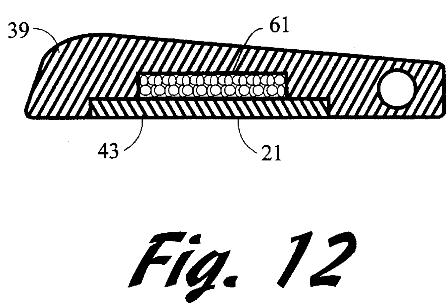Tired of those Purely Struck Approach Shots Flying 10 Yards Long (Directly Over The Pin)?
Doesn’t it always happen that way? You strike that perfect 6-iron and it is going directly at the pin only to watch is sail 10 yards long because you actually hit the club as it was intended to be hit. Well, one option would be to practice so that you always strike the ball right in the sweet spot; but a far easier option would be to deaden the sweet spot so that those purely struck shots (you know, the 10 percenters) only go as far as your normally struck shot when you are ½ inch toward the toe or the heel.
Well, that is the basic premise found in USPN
As seen in FIG. 1, the striking face 21 of a known golf club 23 has a useful area defined by a center area 25, a high area 27, a low area 29, a toe area 31 and a heel area 33. These are general designations, the general areas do not have specific boundaries. Within the center area lies the sweet spot 35 which is the center of gravity of the head. A ball hit from this spot will travel farther than an off center hit, all other things being equal. The reader wishing to know more about the physics of golf will find voluminous literature available. As the point of contact with the ball moves away from the sweet spot 35 the distance reaction will decrease.
FIG. 2 illustrates this phenomenon by illustrating the distance reaction “face map” for typical numbers five and six golf irons. The distance reaction for each area of the club face is marked along the Y-axis with C being center, L low, HG high, HL heel, and T toe. Ball flight path variation is show as deviation on the X-axis. The typical iron has a substantially uniform stiffness over the striking face. It will be appreciated that, depending on where the striking face 21 contacts the ball, a distance reaction variation, or spectrum, of over fifteen yards may result. A ball may land over the green, on the green, or in a sand trap within this distance reaction spectrum.
Psychologically, a golfer will select his specific distance club assuming he will hit the ball on center and get maximum distance from his shot. Realistically, the average golfer would probably be better off assuming an off center hit and going down a club number, or “over clubbing”, to get the same desired distance as from an on center hit with his higher numbered club. This is because the average nonprofessional golfer lacks the skill necessary to contact the sweet spot consistently. That is, he is more likely to hit off center than on center. However, his score still suffers when he hits the lower numbered club on center and the ball goes too far. This is why golf is always a challenge.
.
.
.
.

As seen in FIG. 12, the area behind the center of the striking face 21 and the plate 43 may be comprised of a plug or insert 61 of less stiff, or softer, material than the club head 39 extending midway through the thickness of the club head and with the plate 43 being affixed thereover
Sure beats hours on the range!
David Dawsey – The Golf Attorney
PS – check out interesting putter patents HERE
